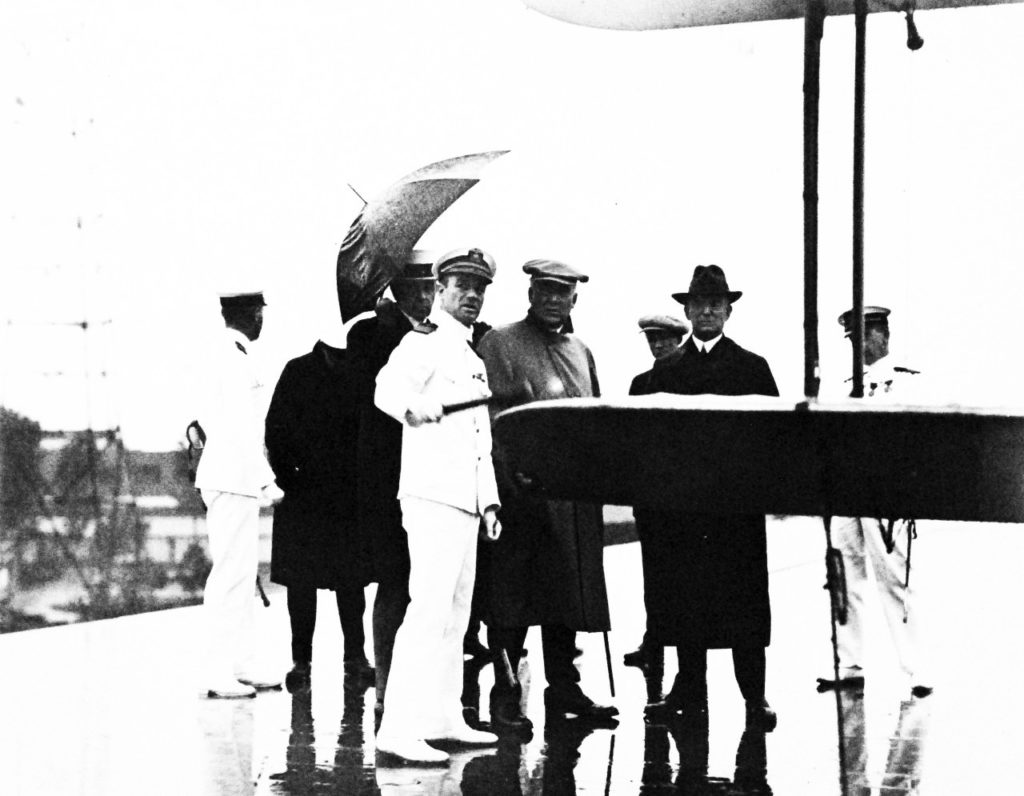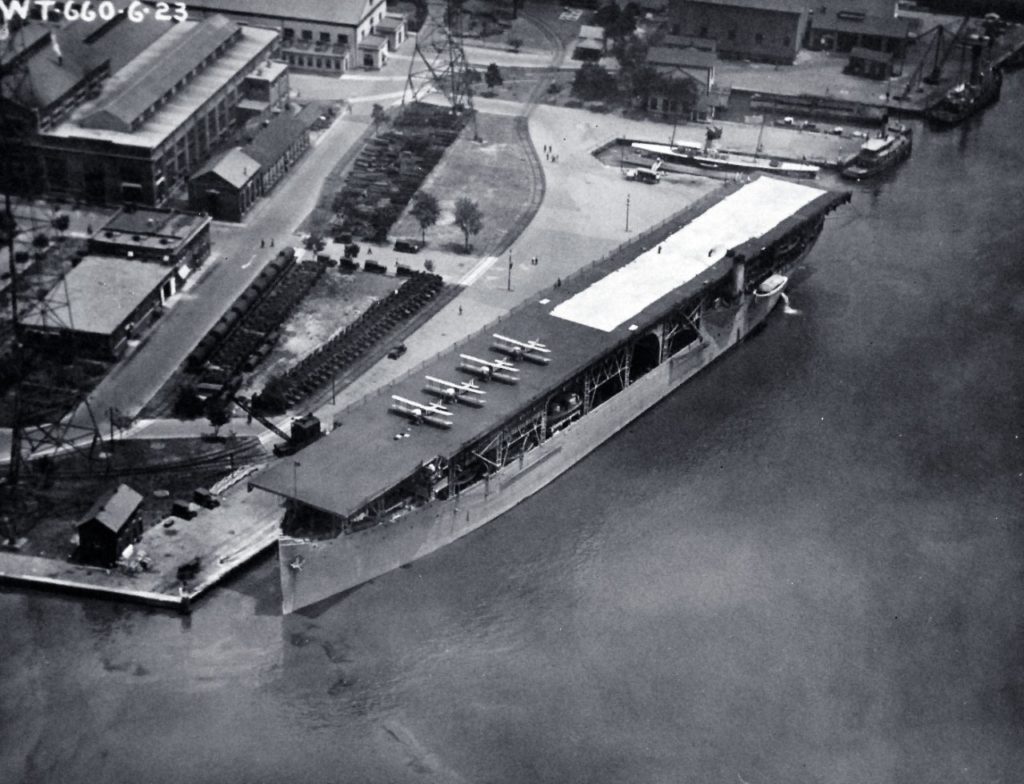
By NHF Staff Historian Dr. Dave Winkler
Sea Power, October 2016
On April 10, 1922, at hearings of the Senate Subcommittee of Naval Affairs, Sen. David I. Walsh of Massachusetts asked Lt. Willis B. Haviland, a pilot who had been assigned to a recently commissioned ship, “What is the Langley?” Haviland responded, “She is a poor excuse for an aircraft carrier.”
Haviland was not being flippant. Though the carrier had been commissioned three weeks earlier, much work needed to be done before the ship that had once served as the collier Jupiter could depart the Norfolk Naval Shipyard. One individual well aware of the U.S. Navy’s first carrier’s limitations was the chief of the recently created Bureau of Aeronautics, Rear Adm. William A. Moffett.
In an austere budgetary climate, Moffett desired larger, more capable aircraft carriers. The recently concluded Washington Naval Conference had placed limits on the number of new battleships and battle cruisers that navies could construct, and the U.S. Navy had just laid down the keels for the planned battle cruisers Lexington and Saratoga. With extensive topside modification to those cruisers, Moffett would have the ships he wanted. The key would be Congressional funding. Langley would play a role in assuring that funding.
Following inaugural flight operations in the Chesapeake that fall, Langley wintered off Pensacola to enable more pilots to get their “carrier quals.” Upon the carrier’s return to Norfolk in May, the commanding officer, Capt. Stafford H.R. “Stiffy” Doyle, was summoned to Washington to meet with Moffett and other Navy officials to preview a forthcoming relations ploy to impress national leaders and the public with the wonders of carrier-based naval aviation.
On June 1, Langley pulled in her lines from Pier 2 of the Norfolk Naval Operating Base and logged “underway” at 8:04 in the morning. However, upon clearing Hampton Roads, she turned left into the Chesapeake Bay rather than returning to sea. Joining Doyle and his navigation team that morning was a Washington Navy Yard pilot. At 3 p.m., Langley turned into the mouth of the Potomac River, with the minesweeper Sandpiper following astern. Not desiring to arrive in the nation’s capital before sunrise, Langley anchored off Blackstone Island off Southern Maryland at 10:30 p.m. and raised the hook just before 4 a.m. to proceed up river. At 8:20 a.m., wind conditions were acceptable to launch four aircraft piloted by Lt. Cdr. Virgil Griffin, Lt. J.R. Kyle, Lt. W.R. Dillon, and Boatswain Anthony Feher to fly ahead to Naval Air Station Anacostia. At 9:23 a.m. with Mount Vernon and the tomb of the first president off the port beam, Langley rendered honors. Before noon, Langley tied up starboard side to the dock at the Washington Navy Yard. Waiting ashore were the four pilots who had flown off three hours earlier. Captain Doyle departed the ship for a short call on the Commandant of the Washington Navy Yard.
The next day, Sunday June 3, the crew of the Langley welcomed 1,198 Washingtonians and others to tour their unique vessel. With the work week commencing the next day, Langley casted off from the Navy Yard and proceeded to a spot off Haines Point, a short distance away from the Army War College at Fort McNair. Once anchored, the USS Mayflower came alongside. President Warren G. Harding, Rear Admiral Moffett, the Navy’s General Board, and several other dignitaries worked their way up to the flight deck to observe Lt. Cdr. Griffin, Lt. Harold J. Brow, Ens. C.D. Palmer, and Boatswain Feher take off and land with their Navy biplanes. With the flight demonstration’s successful conclusion, the visiting dignitaries departed, and Langley returned to her previous berth at the Navy Yard. The flight operation routine continued off Haines Point for the next few days with only minor disruptions.
During the following weekend, Langley remained berthed at the Navy Yard as one of her aircraft, and 30 Sailors participated in the parade that was part of festivities associated with a Shriners convention. Again, the quarterdeck was open to visitors, and several hundred took advantage of the opportunity. On Monday June 11, with Langley still tied up starboard side facing the Navy Yard, Mayflower came alongside and President Harding spent another 45 minutes visiting the aircraft carrier. At 4:02 the next morning, Langley hauled in lines from the Navy Yard dock for the last time as she headed down the Anacostia and the Potomac to return to Hampton Roads that evening. Following an overnight anchoring, Langley once again returned to Naval Operating Base for some maintenance and repair work.
That day back in Washington, President Harding felt “stronger than ever” about the Navy’s plans for fleet aviation and reconfirmed his support for funding to continue the conversion of the planned battle cruisers Lexington and Saratoga into aircraft carriers. Having seen the persuasive powers of his experimental carrier captivate the president, Moffett was determined to garner additional support for his program and arranged for Langley to visit additional northeastern ports that summer.

Naval Aviation – The Past is the Prologue to the Future

As we conclude our three-part history of Naval Aviation, we recommend Admiral James Holloway’s Aircraft Carriers at War: A Personal Retrospective of Korea, Vietnam, and the Soviet Confrontation. As we ponder the future of carrier-based Naval Aviation, we should reflect on the wise words of Admiral Holloway in his aptly-tiled concluding chapter, ‘The Future; Past is Prologue:’
“The importance of the aircraft carrier in our nation’s defense lies in the fact that the carrier is the only weapon system that can provide air power at sea; and the free use of the world’s international waters will be in the future … an absolute essential to our national security strategies” (438-439).
What do you think? Do you have an opinion or comment? Share it with us on our Thursday Tidings webpage!

